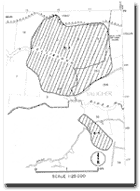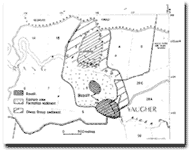8.2 Bunker Hill - Fault and Older Volcanic Basalt
|
This information has been developed from the publications:
|
| Location: | 8-155335. Nine kilometres west of Gellibrand. | |
Access: | Bunker Hill Track. | |
Ownership: | Private land and some Crown land. | |
Geology/Geomorphology: | The Gellibrand River follows the alignment of the Loves Creek and Bunker Hill Faults and has eroded a window into the Lower Cretaceous Otway Group sediments. These occur north of the river while on the southern side are sediments of the Eastern View Formation. Included in these are small intrusions and flows of Older Volcanic basalt which are exposed on the northern slopes of Mount Murray and at river level. A massive landslip is conspicuous on the northern valley slope with a deep headwall scarp just below the ridge crest and irregular lobate ridges of slip material at the valley base. | |
Significance: | Regional. Along with other outcrops in the Gellibrand district, these are the only surface volcanic rocks in the Otway region. The Gellibrand River where it crosses the Otway Group has steep valley side slopes and lacks a floodplain and this contrasts with areas downstream where it crosses less resistant Tertiary rocks (Sites 7.7 and 7.9). | |




